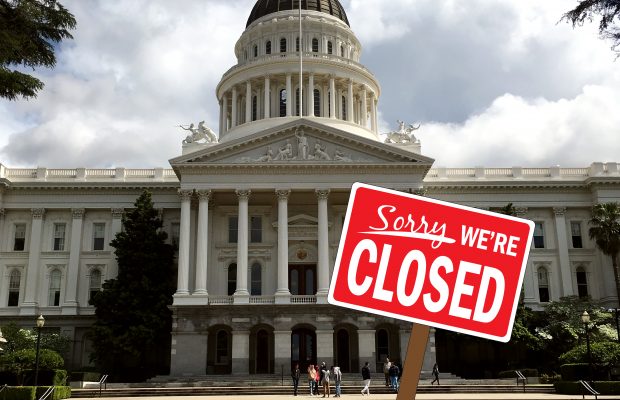Government Shutdown has lasting effects

Winter time is usually the season for celebrating the holidays, the new year and going on a vacation. Winter time is usually the season where people are worrying what presents to gift to their friends and family. Winter time is not, however, usually the season where people are worrying about how they will pay for their next meal.
In November, President Donald Trump stated that he would be “proud to shut down the government for border security.” On Dec. 22, 2018, he did just that. At 35 days, this shutdown was the longest shutdown in United States history, passing the previous record after 22 days on Jan. 12, 2019.
Government shutdowns occur when Congress cannot agree on how to appropriate funds. In this case, the Democrats and Republicans reached an impasse on how to approach border security. Trump advocated for several billion dollars to go into funding a border wall, which he believed would cut down the number of immigrants trying to come into the United States from Mexico. However, the Democrats believed that that money could be spent on improving the border security that is already present now. Eventually, it became clear that a compromise would not be reached, and the government shut down.
During a shutdown, federal programs deemed non-essential close. “We’ve had shutdowns before and employees have had to even work without pay or go without pay and stay home,” Steve Johnson, history teacher, said. “It seems like as our two political parties have become much more partisan that they’re looking for different tactics to try to advance their agenda.” While there have been government shutdowns before, this shutdown lasted the longest and did the most damage to workers for the federal government.
During this shutdown, 800,000 of the 2.1 million workers employed by the federal government were affected in some way. Some workers were sent home with no work or money, while others were brought back to work without pay. National parks and museums closed, and programs like the Transportation Security Administration had workers work without pay. Some TSA employees participated in a “sick-out,” calling in sick so they would not have to work without pay. The Food and Drug Administration stopped its inspections of seafood, fruits, vegetables and other foods that are easily contaminated. Most Internal Revenue Service operations also stopped during the shutdown.
Trump gave the impression that the shutdown could last months, even years, but luckily it ended much sooner, on Jan. 25, 2019. Air traffic controllers at LaGuardia Airport in New York, one of the busiest airports in America are speculated to be the reason for the temporary lift of the shutdown. Too many controllers called in sick, and the airport was forced to stop all flights because there were not enough workers to ensure that the planes would land safely. This caused a chain reaction, and many flights were delayed all across the East Coast. Shortly after, Trump agreed to temporarily lift the government shutdown. He signed a resolution that keeps the government open until Feb. 15.
With the government reopened, workers are starting to get their money back. However, many of them were not required to work without pay, so they do not get any money from the time. There are also many longer lasting effects of the shutdown. Some court cases that had to be postponed because of the shutdown may not be heard for years. Areas of national parks were destroyed from an overflow of waste and vandalism because there weren’t any workers maintaining them.
In the long run, Johnson believes that this shutdown will have severe consequences in the future. “I think a lot of times people take a pretty big pay cut to do government. They are sacrificing to serve our country and they could be making a lot more money, in many cases in the private sector,” Johnson said, “This may discourage them to think that something out of their control could cause this calamity to happen.”
People affected
Food inspection, airport security, medicare, almost all the functions of the government basic to people’s everyday life was on shut down. For 35 days, over 800,000 government employees ranging in nine federal departments no longer received pay. All of these people lived in the stress and pressure of not knowing when the government would reopen.
One out of the 800,000 was Andrew McCurdy’s, junior, father. Andrew’s father works in the FBI and worked without pay during the shutdown. As their financial income came to a halt, expense became a prior and concerning issue.
“My mom has definitely been a lot more careful with food. Now, she plans out what we are going to eat and on what days. She makes it a plan and hangs it on the fridge and would even make meat for the whole week,” McCurdy said.
While the government has been through partial shutdown in the past, this shutdown became the new record-holder for the longest U.S. government shutdown in history. Waiting became the main job for many of these government workers.
“I knew (my dad) was really worried. One day he had me skip school just so we can go do something fun because he was stressed out about it,” McCurdy said.
The government is now reopened for three weeks while President Trump continues to make negotiations with the Democrats on the funding of the border wall. In this uncertain and unstable circumstance, the families of those who were affected by the shutdown continue to prepare themselves for a future shutdown.
“We have basically put all major expenditures on hold and are only buying necessities until things are a bit more stable,” McCurdy said.
The local national park, the Santa Monica Mountains, and its many workers were also affected by the shutdown. Services and programs throughout the park were suspended, causing park rangers, volunteers and interns to be temporarily out of work, without pay.
“It really sucks,” Fairy Noorzay, junior and volunteer with the Parks Service, said. “I feel like the shutdown itself was a little bit pointless and it sucks that it went on for that long and that it lead to all this with the vandalism of the National parks because they’re beautiful places.” National Recreation areas such as Joshua Tree were unregulated during the shutdown, leading to the accumulation of trash in natural sites and the burning of native plant species. Trail posts and boulders throughout the Satwiwa National Recreation Area, Newbury Park’s local national park, are now covered in graffiti.
After recent fires swept through the Santa Monica Mountains, obliterating 90% of the land, several regeneration projects were scheduled after the burn to help foster native regeneration in the park. However, with the government shutdown, projects such as these were suspended.
“I was sad, because It’s really fun to work by Boney (mountain) and to be going to Satwiwa every week,” Noorzay said. She is happy to have returned to the ranger station, but as the government is only open for a few weeks, she and her co-workers remain unsure about their positions in the parks.
Students at NPHS also felt the effects of the shutdown, as several governmental sites such as NASA and NOAA were out of service during the month-long period. Victor Ke, senior, was unable to do his environmental science homework because the NOAA database was not available. “
What is being done now
Although the government reopened on January 25th, the discussion surrounding the shutdown is far from over.
During the shutdown, on January 16th, Trump signed the Government Employee Fair Treatment Act of 2019. This legislation was intended to ensure that workers receive compensation after the shutdown. Now, workers are receiving back pay for the work they completed during the shutdown, and furloughed workers will be paid as well.
“They gave us a lot of promises like, we’ll pay for your part of your gas or part of this, part of that,” McCurdy said.
However, the unprecedented length of this shutdown has led several Senators to search for solutions to prevent future shutdowns.
“Both parties have been talking about legislation to make sure that a shutdown would not harm any workers or prevent government services from being offered should a budget impasse happen again, and that way eliminating it as a tactic to gain advantage,” Johnson said. Such legislation has been proposed by those on each side of the political spectrum. Republican Senator, Rob Portman of Ohio proposed the End Government Shutdowns Act, while Democratic Senator, Mark Wagner of Virginia introduced the Stop STUPIDITY Act, or Shutdowns Transferring Unnecessary Pain and Inflicting Damage in the Coming Years. A group of bipartisan lawmakers proposed the Solidarity in Salary Act of 2019, and a group of House freshmen Democrats introduced the Shutdown to End All Shutdowns Act. Most of these bills involve stopping funding at a set point, then slowly decreasing it over time. Others recommend a series of punishments for congressional lawmakers and the president as a shutdown continues, while another suggests suspending payment for lawmakers and the president. The House majority leader, Steny Hoyer, democrat, suggested making it illegal for federal workers to work without pay.
While there is no shortage of potential legislation on how to approach government shutdowns, the position of workers and the government remains uncertain, given the Feb. 15 deadline. Morale is also steadily declining among federal workers, leaving some with concerns about future recruitment.



